Reviews and recommendations are unbiased and products are independently selected. Postmedia may earn an affiliate commission from purchases made through links on this page.
Fruit, nuts and know-how go into creating delicious churchkhela food
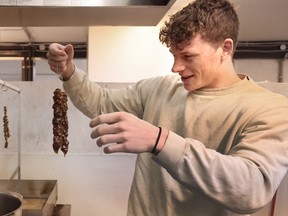
A Vancouver-based company Chella is bringing a staple of Caucasus’ cuisine to local markets with Chella churchkhela.
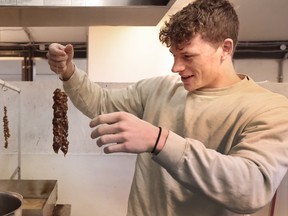
Article content
The country of Georgia is earmarked as the earliest recorded location of winemaking in the world, with a tradition dating to 6000 BC.
But the transcontinental nation straddling both eastern Europe and west Asia is also a rising star on the global food scene. Across Europe, North America and elsewhere, chefs and consumers alike are embracing the country’s rich culinary heritage with its focus on dishes that allow the flavours of fresh ingredients to speak for themselves.
Article content
Among the most common of these ingredients is churchkhela.
The so-called ‘superfood’ is made from walnuts threaded onto a string and then dipped in a combination of thick fruit juices and spices, which are then hung to dry in the shape of a candle. Variations on the recipe are found throughout the Caucasus’s region and beyond from Iran to Greece.
Vancouver-based company Chella is bringing churchkhela to B.C.
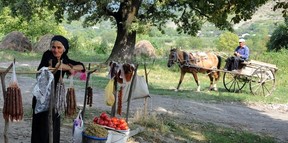
Tomasz Bernard, Mark Dubman, Daniel Nielsen and Sherwin Mirzanjanian founded Chella in January 2023. The quartet aims to make the vegan-friendly food familiar to all with its “snacking-through-history” tag.
Advertisement 2
Article content
“Sherwin has heritage in the area and Mark’s family emigrated from Russia after spending time in Georgia, so they introduced the rest of us to churchkhela,” said co-founder Nielsen, 23. “It was actually Mark’s family friend who brought the first churchkhela we tasted over. The flavour, the cultural significance, and history of the product instantly captured all of our interests.”
Typically manufactured in the autumn at harvest time, churchkhela is produced by boiling grape or other fruit juice down and then thickening it with flour into a mix called a badagi. Once cooled, strings of nuts are dipped into the concentrate until completely covered and left to hang-dry in the sun. This process is repeated a few times before the final product is ready to eat.
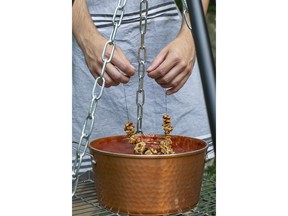
Traditionally, churchkhela served as a portable snack or troop ration prized for its portability, longevity and power-packed nutritional contents. While still a staple for rural labourers and shepherds, you find the product on modern tables served with wine or strong black tea as part of the renowned Georgian hospitality around food-sharing.
Article content
Advertisement 3
Article content
Nielsen notes that all of Chella’s founders are avid outdoors enthusiasts and that churchkhela is a perfect companion food for hikes, paddles, winter sports and more.
“There is 3,000-year-old recorded history of everyone from Silk Road traders to troops on the march packing it for the road as it is so good for providing beneficial calories,” said Nielsen. “We recommend finishing our churchkhela within three months of purchase, but it can easily last a lot longer. That you can achieve that without adding any additional sugar or preservatives is just one more benefit of the product.”
Chella’s product line includes four flavours — classic grape, pomegranate, apricot and the unique apple pie — and comes in a variety of shapes and packaging.
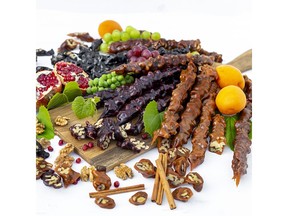
“The traditional design is pretty cool as you can use the string to actually cut off portions, so you don’t need a knife,” said Nielsen. “But we found from market research that customers were interested in smaller bite-sized portions that could be put in a resealable bag for on-the-go, so we made Chella Bites. Finally, we developed the Sweet Sujuk (sausage) fruit rolls in strawberry, kiwi and grape.”
Advertisement 4
Article content
From sauces, stews, dips and spice mixes, walnuts are a featured ingredient in so much of Georgian cuisine. Sourcing the nuts, along with some of the other ingredients, has been one of the harder aspects of bringing the product to the local market.
“One nice thing about launching at the Vancouver farmers markets has been making connections with local growers who often may have a bunch of walnut trees that they don’t presently have any use for that we can access for supply,” he said. “Obviously, finding fruit isn’t as challenging here, but it takes a lot of it to make a recipe. It was also very touch-and-go with a lot of tasting experiments with things like peach, mango to eventually arrive at the final, best four flavours we have now.”
Of these flavours, apple pie is the one that falls outside the traditional recipes. Call it a North American fusion flavour.
“The apple pie was a bit of inspiration that one of us had to add a bit of cinnamon and then other spices,” he said. “That we wound up with something that really tastes like apple pie was really cool. It’s incredibly popular.”
Advertisement 5
Article content
Since debuting at the Vancouver Farmers Market last spring, things have taken off for Chella.
Expanding into a commercial kitchen by May to meet demand, the company’s first online sale was in July.
Today, the products are available at nine Lower Mainland locations as well as Pepper’s Foods in Victoria. Nielsen says the fact that they have a vegan product with a positive nutritional profile has helped Chella to gain market entry. He would like to see the products on shelves at outdoor stores as an alternative to heavily processed corporate power bars.
“We would love to get into stores like MEC and a couple of others because we are all avid outdoors people,” he said. “It also has good placement as a brain food for work and studying.”
At the moment, the company goal is to perfect the current product before branching off into other Georgian delights. That said, there is a kind of chocolate and nut log they’re eyeing.
Recommended from Editorial
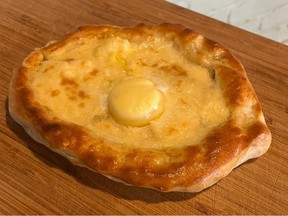
Acharuli Khachapuri
One of the most popular foods after churchkhela in Georgian cuisine is the stuffed bread known as khachapuri. This cheese-loaded version of the dish is a great addition to any table:
Advertisement 6
Article content
Dough
40 oz (1.15 kg) flour
1 cup (250 mL) water
1 cup (250 mL milk
1 egg
1 tbsp (15 mL) yeast
1/8 cup plus 4 tsp (50 mL) oil
Heat the water to 95 F and stir in the yeast. Take a separate bowl and add in 1 kg of flour. Make a well in the middle. Add the yeast/water mixture, oil, egg and milk. Mix the ingredients from the middle of the bowl. Make the dough into a ball and cover. Leave in a warm place for two hours to rise. Once risen, add the last 150 g of flour and knead the dough and let it rest for 10 minutes.
Filling
3 eggs
20 g (0.7 oz) butter
100 g (4 oz) grated Sulguni cheese (low moisture mozzarella is a popular substitute)
100 g (4 oz) grated Imeretian cheese (you can substitute with half mild feta and half ricotta)
Preheat the oven to 425 F. Grate the cheese. Combine the grated cheese, one egg, and butter in a mixing bowl. Mix the ingredients with a fork.
Shape the dough into a flattish oval. Spread the cheese filling onto the middle of the dough. Fold the sides and the ends of the dough.
Lightly dust a baking tray with flour to prevent sticking. Place the khachapuri in a preheated hot oven for about 12 minutes. Remove the khachapuri, glaze the surface with the egg yolk, and add a raw egg on top of the cheese. Bake for an additional three minutes at 425 F. Additional toppings such as spinach, herbs, cured meats and more can be added to suit preference.
To serve, mix the butter and egg with a knife and fork, and share every bite alongside small pieces of the bread portion.
Makes 4-6 khachapuri.
Bookmark our website and support our journalism: Don’t miss the news you need to know — add VancouverSun.com and TheProvince.com to your bookmarks and sign up for our newsletters here.
You can also support our journalism by becoming a digital subscriber: For just $14 a month, you can get unlimited access to The Vancouver Sun, The Province, National Post and 13 other Canadian news sites. Support us by subscribing today: The Vancouver Sun | The Province.
Article content
Source: vancouversun.com



